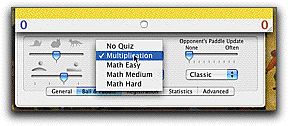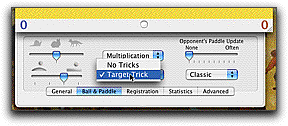The rise of the Machine
Before you make a casual advance on your friends and get humiliated, we recommend you spend some time playing against the machine to sharpen your skill.
The program opens ready to play against the machine.
Just double click on the board, (or Game->Start [Cmd-G] in the Menu)
and you are ready to go.
In this mode, human (that is very likely, you) is always on the left (defende's) side.
A match starts by you clicking on the board.
Whoever scores will gain a credit of one, until a party gains five points.
The Human strikes back : Some Hints for Survival
You should have found out that the way paddle is moving at the time of hitting the ball affects the way it bounces (the direction and its speed as well as some special modes to be explained later). Obviously, if the paddle was moving fast toward your opponent when you hit the ball, the ball will bounce back with increased speed. To keep the match from going crazy too fast, there is a maximum cap for gaining speed this way.
Not only the speed, but the direction of the rebound may be varied by the direction of the paddle movement at the time of the impact.
It is based loosely on some physics. Most of you should be familiar with the way a ball bounces off a smooth surface at rest. Most of the time, your paddle will be in a moving state when the ball hits on it. Therefore, you may view the impact from the view point of an ant riding on the paddle. To it, the direction of the impending ball will have its velocity altered from that you observe as a static observer.
The usual equal-angle reflection rule applies to the ant's eye, not yours, and the ball bounces off accordingly. The result is not what one would expect from an instantaneous snapshot of the ball and the paddle upon the impact.
Currently we are trying to publish this astounding discovery in a prestigious journal, but so far nobody understands its importance, or seems to believe (erroneously) that some one named Newton or Galilei already published it somewhere.
Anyway, the essence of this is that you can control the direction of the ball bounced off by moving the paddle in certain directions at the time of the impact.
Another way to control direction of the bouncing ball off your paddle is to utilize its bent shape, if you choose a round shaped paddle. As a resident of Euclidean three dimensional world, you should have some good intuition already how a ball bounce off either a flat or crooked surface. This, along with the moving paddle effect mentioned above, you have more or less full control of how the ball bounces off. The paddle curvature can be selected from a few options in the Ball and Paddle tab of the tool chest.
A perceptive player will notice soon that the pace of the game gradually quickens as both parties do not yield easily. That is, if you manage to exchange the ball across the table more than 10 times, the maximum allowed cap for rebounding speed will be increased by a certain amount of the current value. Therefore, the longer you last without scoring, the allowed ball speed increases and compounds. So, you are pretty much guarranteed to finish a match before too long, if you are a human.
Gaining Spells and How to Defeat Them
If you are a student just starting to learn the multiplication table,
you can make good use of rendezvousPong by choosing the math challege mode. To enable it,
first make sure that you are not in the middle of playing a game.
Just click on the bottom area of the window where the scores are displayed. A tool chest will open.
(You can do this also from the menu Game->Tweak) In the Ball and Paddle tab, center column, you will find two
pull down menus. Click on the top pull down menu bar and select appropriate level for math challenges.
 During the game play, after every few hit-backs, you will be confronted with a simple math question. If you type in the correct answer in time, your next hit will gain significant boost and put the opponent under pressure to counteract. Of course, this will not automatically lead to your scoring. So do not take your gaurd off just yet!
During the game play, after every few hit-backs, you will be confronted with a simple math question. If you type in the correct answer in time, your next hit will gain significant boost and put the opponent under pressure to counteract. Of course, this will not automatically lead to your scoring. So do not take your gaurd off just yet!
Another way to gain advantage is to hit the ball dead at the center of your paddle. (To enable this,
now choose "Target Trick" in the second pull down menu.)
 With this on, when you hit the ball at dead center of the paddle, it will turn pulsating red, and your opponent will come up with the appropriate measure to counter it.
With this on, when you hit the ball at dead center of the paddle, it will turn pulsating red, and your opponent will come up with the appropriate measure to counter it.
So, if you find yourself at the receiving end of the spell, what should you do?
Your paddle will display a small, white, pulsating dot. You should try to hit the ball back on the spot to cancel the spell cast on you.
If you fail to do so, the paddle will get out of hand, spin for a few seconds. Your opponent will try to score while you remain helpless.
There are ways to fine tune the math and target challenge behavior to match your level of dexterity.
To do so, you go to the Advanced tab in the same tool chest, and may experiment with various level settings.
If you are not sure, just reset to the Factory setting. The detailed meaning of the parameters are described in
Fine-tuning Challenge Parameters section of the manual.
We tend to believe that there is a virtue in keeping a small program like rendezvousPong simple and clean. Every player should be able to come up with a fantastic idea about different type of spells. Lest too many bells and whistles steal true nature of pong in its Zen-like philosophy, we stopped at these two features.
If you have a compelling idea, however, feel free to contact us.
Summary
Just read the occasional instruction carefully on the screen and click or double click to play against the machine.




